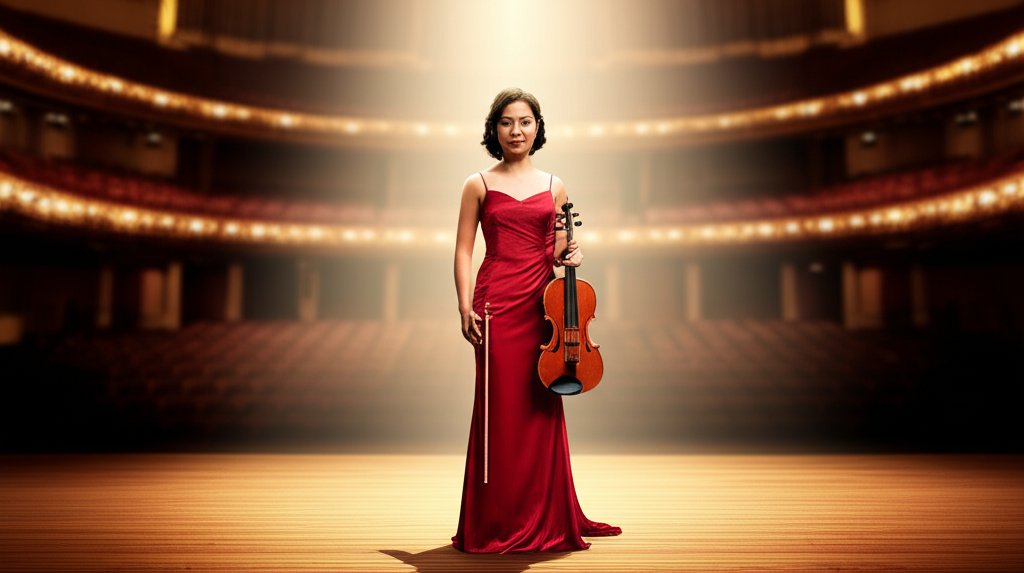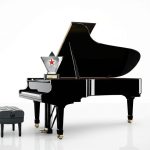The moment you step on stage is electric. But for a rising soloist in a concerto competition, the true test—and the ultimate thrill—isn’t just playing for the judges. It’s the profound experience of turning around to face a sea of musicians, raising your instrument, and leading a full orchestra. This collaborative performance is often the final hurdle, separating the skilled from the truly exceptional and offering a glimpse into the life of a professional artist.
This isn’t just about winning; it’s about making music on a scale most young performers only dream of. The synergy between soloist and orchestra creates a sound that no practice room or piano-accompanied audition can ever replicate.
At a Glance: Your Orchestral Performance Guide
- Distinguish the Stakes: Understand the crucial difference between competitions offering piano accompaniment versus those culminating in a full orchestra performance.
- Prepare Like a Pro: Learn the specific strategies needed to prepare for the unique demands of playing with an ensemble of 50+ musicians.
- Know What Judges Look For: Discover the key qualities judges seek in a soloist’s orchestral performance, which go far beyond technical perfection.
- Compare Competition Structures: See how different events, from regional contests to international festivals, structure their orchestral rounds.
- Master the First Rehearsal: Get a step-by-step playbook for navigating your first, often brief, rehearsal with the conductor and orchestra.
More Than a Prize: Why Orchestral Performance Is the Real Win
While cash awards and prestigious recital opportunities are valuable, a concerto competition that culminates in a performance with an orchestra offers a prize of a different magnitude: experience. It’s a trial by fire that forges a musician’s collaborative instincts, leadership, and stage presence.
Competitions like the American Fine Arts Festival (AFAF) offer winners a highly coveted recital at Weill Recital Hall at Carnegie Hall—an undeniable career milestone. However, this is a solo or duo performance. In contrast, events like the International Young Artist Concerto Competition (IYACC) build the orchestral experience directly into their structure. For their 2026 event, both semi-finalists and finalists will perform with the professional SEEN Worldwide Orchestra, giving more musicians access to this invaluable opportunity.
This is a critical distinction. Playing with a piano accompanist tests your interpretation and technique. Playing with an orchestra tests your ability to lead, listen, and adapt in real time. You learn to project over a string section, blend with the woodwinds, and feel the powerful support of the brass. This is the skill set of a touring soloist, and acquiring it early is a massive advantage.
Not All Orchestral Rounds Are Created Equal
When you start exploring opportunities, you’ll find that “orchestral performance” can mean different things. Understanding the structure helps you align a competition with your personal and professional goals. While a comprehensive Concerto Competition 2025 Guide shows the full landscape, most events fall into one of these models.
1. The Fully Integrated Model: Orchestra in Multiple Rounds
This is the gold standard for aspiring soloists but is relatively rare due to logistical complexity. In this model, performing with the orchestra is a core part of the competition process itself.
- Example: The International Young Artist Concerto Competition (IYACC) is a prime example. By having participants perform with an orchestra in both the semi-final and final rounds, the competition provides an immersive experience. Judges can assess how a musician handles the pressure and collaboration over multiple performances.
2. The Winner’s Showcase Model: The Final Prize Performance
This is the most common structure. The competition rounds are held with a piano accompanist, and the grand prize winners are invited to perform with an orchestra in a special concert.
- Example (Festival Setting): The Jan and Beattie Wood Concerto Competition at the Brevard Music Center is open only to its full-session instrumental students. The winner performs as a featured soloist with the BMC Orchestra in the “Soloists of Tomorrow” concert—a highlight of the festival season.
- Example (Regional Symphony): The Bellevue Symphony’s Young Artist Concert selects four Grand Prix winners (two junior, two senior) from Washington, Idaho, or Oregon to perform with the symphony. The competition itself is done via video submission with piano, but the prize is the concert itself.
3. The Future Engagement Model
Some competitions award a future concert date with a specific orchestra as the prize. The competition itself is entirely with piano accompaniment, and the winner might perform in the orchestra’s following season. This is still a fantastic opportunity but offers a delayed gratification compared to the other models.
The Soloist’s Playbook: Preparing for Your Orchestra Debut
Success in an orchestral final begins months before you ever meet the conductor. Your preparation must go far beyond simply memorizing your notes.
Step 1: Achieve Unshakable Technical Command
Your part must be so deeply ingrained that you can play it flawlessly even when distracted or nervous. The orchestra and conductor rely on you to be the anchor. Most high-level competitions, like the Jan and Beattie Wood, require all rounds to be memorized for this very reason. There is no safety net when you are the soloist.
Step 2: Live with the Full Score
This is the single most important step that separates amateur soloists from professional ones. Don’t just learn your part; study the full orchestral score.
- Know Your Cues: Identify which instrument or section plays right before your entry. Is it a flute solo? A horn call? A pizzicato from the cellos?
- Understand the Harmony: See how your solo line fits within the orchestral texture. Are you playing with the harmony or against it? This knowledge will inform your phrasing and dynamics.
- Map the Tutti Sections: A “tutti” (Italian for “all”) is where the full orchestra plays, often without the soloist. Know exactly what happens in these sections so you can anticipate the character and tempo of your next entrance.
Analogy: Thinking you can lead an orchestra by only knowing your part is like a quarterback trying to run a play knowing only their own route. You have to know what the entire team is doing to succeed.
Step 3: Use Your Piano Accompanist Strategically
Your accompanist is your stand-in orchestra during preparation. Use your rehearsal time to practice the collaborative elements.
- Practice Entries and Cutoffs: Rehearse coming in after long orchestral introductions or rests.
- Communicate Visually: Practice giving non-verbal cues with your body language, breathing, and instrument—the same cues a conductor will look for.
- Simulate Tempo Changes: Work on ritardandos and accelerandos, ensuring your accompanist is following your lead.
Step 4: Watch and Learn from the Masters
Spend hours on YouTube watching professional soloists perform your piece with different orchestras and conductors. Don’t just listen—watch.
- How do they communicate with the conductor?
- How do they interact with the concertmaster?
- How does their physical presence command the stage?
The First Rehearsal: Making Your Mark in 60 Minutes or Less
You will likely get very little rehearsal time with the orchestra—often just one run-through. You must be efficient, professional, and collaborative from the moment you walk in.
Your First Rehearsal Checklist:
- Introduce Yourself to the Conductor: Arrive early. Greet the conductor and concertmaster. In 30 seconds or less, mention one or two key interpretive points. For example: “Maestro, thank you for this opportunity. Just so you know, I take the cadenza quite freely,” or “I tend to push the tempo slightly at measure 150.” This shows preparation and respect for their time.
- Listen More Than You Play: The sound of a live orchestra is overwhelming at first. During the opening tutti, put your instrument down and just listen. Feel the rhythm, absorb the colors, and get a sense of the ensemble’s timing.
- Project with Purpose: The sound that felt huge in your practice room might get swallowed on stage. You must project your sound with a focused, resonant core. This isn’t about playing louder; it’s about playing with more intensity and clarity. Your pianissimo needs to shimmer, not disappear.
- Lead with Your Eyes and Breath: The conductor is your primary partner, but the orchestra is watching you, too. Use your eyes to connect with key players, especially the concertmaster and principal section leaders. An audible preparatory breath before a major entry is a universal signal that helps everyone come in together.
- Be Assertive, Not Aggressive: You are the leader, but music is a dialogue. If the conductor suggests a different tempo, try it. If a passage isn’t lining up, it’s okay to politely ask, “Could we please try that entrance one more time?” A mature, collaborative spirit is something every judge looks for.
Case Snippet: A young cellist in a regional concerto competition was playing the Dvořák Cello Concerto. During the rehearsal, the principal horn player was phrasing a key counter-melody differently than she had imagined. Instead of ignoring it, during a break, she approached the player and said, “Your line there is beautiful. I’m going to hold back just a little to give you more space.” In the performance, that moment of musical dialogue was a highlight. Her awareness and collaborative spirit were explicitly mentioned by the jury.
Quick Answers to Common Questions
Q: What if the orchestra’s tempo is drastically different from how I practiced?
A: This is a common challenge. The conductor is ultimately in charge of the tempo. Your first job is to adapt. If it feels uncomfortably fast or slow, you can respectfully discuss it with the conductor. Say something like, “I usually feel this section a little more forward. Would you be open to trying it slightly faster?” But be prepared to meet in the middle. Flexibility is a sign of a mature musician.
Q: How much rehearsal time should I expect for a concerto competition?
A: Shockingly little. For many competitions, you may only get one rehearsal, sometimes lasting less than an hour, and perhaps a brief sound check. The IYACC model, with orchestral performances in multiple rounds, is a welcome exception. The limited time underscores the need for you to be flawlessly prepared and hyper-efficient.
Q: Do I need to provide the orchestral parts for the musicians?
A: Almost never. The competition organizer or the orchestra’s librarian is responsible for providing the sheet music for the ensemble. However, you should always verify this in the competition rules. You are, of course, responsible for your own solo part and for providing a piano reduction score for your accompanist in the preliminary rounds.
Q: What’s the biggest mistake young soloists make when playing with an orchestra for the first time?
A: The most common pitfall is playing in a “practice room bubble.” They focus so intently on their own part that they fail to listen to or interact with the orchestra. The second mistake is the opposite: becoming so intimidated by the massive sound that they play timidly and fail to lead. The goal is to find the confident middle ground: lead with conviction while engaging in a dynamic musical conversation.
From the Practice Room to the Main Stage
Choosing a concerto competition is a major strategic decision in a young musician’s career. As you weigh your options, look beyond the application fee and the prize list. Scrutinize the performance opportunity at the heart of the event. Does it offer the chance to collaborate with an orchestra? If so, who is the ensemble? Is it a student group, a festival orchestra, or a professional symphony?
The experience of performing a concerto with a living, breathing orchestra is transformative. It will test your preparation, challenge your musical instincts, and ultimately provide one of the most exhilarating moments of your artistic life. That powerful collaboration is a prize that will resonate long after the applause has faded.
- Texas Piano Competition Recognizes Outstanding Young Talent with Prestigious - November 21, 2025
- International Piano Competitions 2025 Provide Global Stages for Pianists - November 20, 2025
- Piano Competitions for Youth 2025 Open Doors for Young Artists - November 19, 2025










